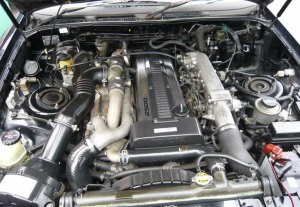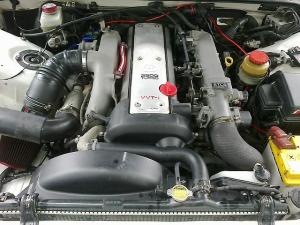
Engine 1JZ-GTE
 The 1JZ-GTE engine is unquestionably a legend, because it is this turbocharged inline-six that gives speed to the seventieth Supra, Mark 2 Tourer V and other fast Toyotas. At its core, the 1JZ-GTE is a turbocharged version of the naturally aspirated 1JZ-GE.
The 1JZ-GTE engine is unquestionably a legend, because it is this turbocharged inline-six that gives speed to the seventieth Supra, Mark 2 Tourer V and other fast Toyotas. At its core, the 1JZ-GTE is a turbocharged version of the naturally aspirated 1JZ-GE.
The first generation 1JZ-GTE was equipped with two turbines placed in parallel along the power plant. Two, relatively small turbines - CT12A, in comparison with the usual 1JZ, increased power by 80 hp. An increase of 80 horsepower for a twin turbo engine is not very significant, especially when you consider the boost pressure of 0.7 bar. It's all about the peculiarities of Japanese legislation, which in those years forbade the production of cars whose power would exceed 280 horsepower. The maximum power of 280 hp is achieved at 6200 rpm of the crankshaft, the maximum traction force of the 1JZ-GTE engine is 363 N.M at 4 rpm.
Updated 1JZ-GTE, 1996
In 1996, the Japanese updated the engine, so the 1JZ-GTE vvti appeared. In addition to the fact that the turbo engine received a variable valve timing system, the twin turbo is a thing of the past. The Japanese instead of two parallel turbines began to install one, but a larger turbine - CT15B.

In addition to changes in the pressurization system, the updated engine received a higher compression ratio. If on engines with two turbines it was 8.5:1, then the single-turbine 1JZ-GTE has a compression ratio increased to 9.0:1. The increased compression ratio allowed to increase the torque to 379 N.M and make the power plant 10% more economical. Quite high, as for a turbocharged engine, compression makes high demands on the quality of gasoline. The 1JZ-GTE engine is recommended to be powered with gasoline with an octane rating of at least 95, and given the unsatisfactory quality of our fuel, it is better to fill in the 98th gasoline to avoid the risk of detonation.
In the 1 1996JZ-GTE, the cooling channels were changed, which reduced the likelihood of engine overheating. The engine geometry has not changed during the modernization: both before and after restyling, the cylinder diameter is 86 mm, and the piston stroke is 71.5 mm. Such engine geometry, when the cylinder diameter exceeds the piston stroke, causes the superiority of torque over maximum power.
Despite the fact that the characteristics of the upgraded 1JZ-GTE “on paper” have improved, the twin-turbine one spins “more fun” at the “top”, for this reason, some of the tuning enthusiasts are looking for the pre-styling 1JZ-GTE twin turbo.
The average fuel consumption of the 1JZ-GTE is stated at 12 liters, but in real conditions the consumption easily increases to 25 liters.
| 1JZ-GTE Twin Turbo | 1JZ-GTE VVT-i | |
|---|---|---|
| Year of release | 1990-1995 | 1996-2007 |
| Volume | 2,5 l. | |
| Power | 280 HP | |
| Torque | 363 N * m at 4800 rpm | 379 N*m at 2400 rpm |
| Compression ratio | 8,5:1 | 9:1 |
| Bore | 86 mm | |
| Piston stroke | 71,5 mm | |
| Turbine | 2 turbines CT12A (pressure 0.7 bar) | 1 turbine CT15B |
Faults and maintenance 1JZ-GTE
Supra owners note that due to poor fuel, the pistons can coke, which leads to a loss of compression in the cylinders. Thanks to a very strong "bottom", decoking allows you to return the compression to values of 12 atmospheres. Killed 1JZ-GTE blocks, despite the active operation by most owners, are not so common, but if necessary, you can order a contract motor. With a timely oil change, which should be done every 7 km, because turbines are also washed with engine oil, 000 km go before replacing the 1GZ-GTE rings. Due to overheating, the rings may need to be replaced much earlier than 300 thousand. With a run of 300 km, it is also advisable to replace the crankshaft oil seal, which may begin to leak at such a run. Unstable idling, as well as dips when pressing the gas pedal, can be caused by a failed air flow sensor.
It is worth noting that the 1JZ-GTE has a cast iron block rather than an aluminum block, which increases the overall weight of the car, but makes the engine less susceptible to overheating.
To increase reliability, the 1JZ-GTE motor was not equipped with thermal clearance hydraulic compensators, therefore, thermal clearances should be adjusted at intervals of 200 km.
The Toyota Supra has a Yamaha emblem on the timing case. The motorcycle company helped develop the engine. You can also recall the Toyota Celica 180, Yamaha took an active part in the creation of a sixteen-valve, high-speed 2.0 engine for this car as well.
The 1JZ-GTE motor was installed on:
- Chaser;
- Crest;
- Mark II, Mark II Blit;
- Above MK III;
- Verosa;
- Soarer;
- Crown.
The 1JZ-GTE engine is known for the widest scope for improvements and power increases. Despite the factory 280 hp, which in itself is not small, it is possible to increase the power to 600 - 700 horsepower by replacing attachments alone.

